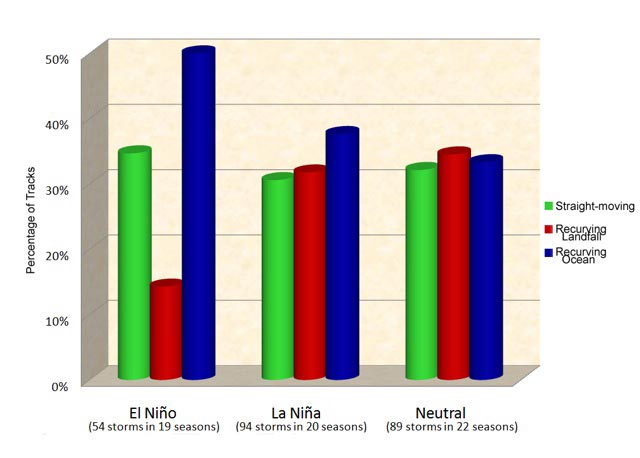Hurricane Season Is Calmer When El Niño Acts Up


El Niño may get a bad wrap for bringing wild weather, but hurricane season during an El Niño year isn't much to fear, according to a new study. Scientists found that tropical cyclones that form during an El Niño year are more likely to curve harmlessly away from land.
Scientists at the University of Miami discovered the "intriguing relationship" between hurricane tracks and climate variability by studying data on hurricane tracks from the Atlantic gathered between 1950 and 2010.
In the study, storms were classified into three different categories based on their projected paths: straight moving, re-curving landfall or re-curving ocean. Storms that develop farther south and/or west in the tropical Atlantic are more likely to become straight-moving storms that ultimately affect the Gulf Coast of the United States and the Western Caribbean. However, storms that form more north or east have a greater chance of curving northward and threatening the Eastern Seaboard or simply curving into the open ocean. [Infographic: Storm Season! How, When & Where Hurricanes Form]
The study found that El Niño seasons were associated with fewer storms overall, and that the storms that did form were less likely to make landfall due to changes in the atmospheric steering currents, which guide the overall movement of storms. El Niño is where waters over the eastern Pacific Ocean are warmer than normal.
The 2009 hurricane season was the least active in 12 years and the lack of activity was blamed on El Niño. That season saw nine tropical storms, three hurricanes and two major hurricanes. An average Atlantic season produces 11 named storms, six hurricanes and two major hurricanes. Of the 2009 storms, only Tropical Storm Claudette made landfall in the United States.
"In a typical El Niño season, we found that storms have a higher probability of curving back out into the ocean as opposed to threatening to make landfall along the East Coast of the U.S. due to a change in the circulation across the Atlantic," said study team member Angela Colbert. "This is important for not only weather forecasting, but insurance companies, who can use these findings when determining seasonal and yearly quote rates."
La Niña seasons, when the equatorial Pacific Ocean surface is cooler than normal, are associated with both greater numbers of storms as well as an increased likelihood that they will make landfall. Last year was an active year in the Atlantic basin, due to a moderate La Niña, with 19 named storms, 12 hurricanes and 5 major hurricanes. None of the hurricanes made landfall in the United States.
Get the world’s most fascinating discoveries delivered straight to your inbox.
The 2011 Atlantic hurricane season is at its peak, and La Niña is predicted to re-emerge after dying down over the summer. The season was forecast to be active and has lived up to that prediction so far with 14 named storms, two hurricanes, both of which became major hurricanes, and one of which, Irene, made landfall along the East Coast.
- History of Destruction: 8 Great Hurricanes
- Hurricanes from Above: See Nature's Biggest Storms
- Weirdo Weather: 7 Rare Weather Events
Follow OurAmazingPlanet for the latest in Earth science and exploration news on Twitter @OAPlanet and on Facebook.



